battery Lancia Delta 2015 Owner handbook (in English)
[x] Cancel search | Manufacturer: LANCIA, Model Year: 2015, Model line: Delta, Model: Lancia Delta 2015Pages: 291, PDF Size: 6.74 MB
Page 189 of 291
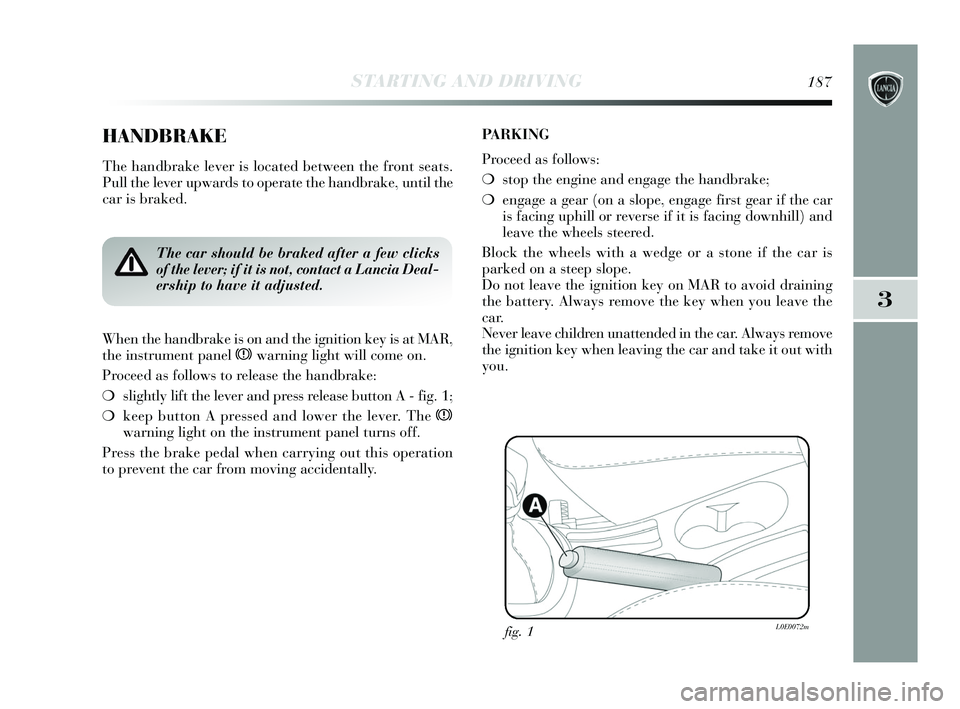
STARTING AND DRIVING187
3
HANDBRAKE
The handbrake lever is located between the front seats.
Pull the lever upwards to operate the handbrake, until the
car is braked.
The car should be braked after a few clicks
of the lever; if it is not, contact a Lancia Deal-
ership to have it adjusted.
When the handbrake is on and the ignition key is at MAR,
the instrument panel xwarning light will come on.
Proceed as follows to release the handbrake:
❍ slightly lift the lever and press release button A - fig. 1;
❍ keep button A pressed and lower the lever. The x
warning light on the instrument panel turns off.
Press the brake pedal when carrying out this operation
to prevent the car from moving accidentally.
PARKING
Proceed as follows:
❍ stop the engine and engage the handbrake;
❍ engage a gear (on a slope, engage first gear if the car
is facing uphill or reverse if it is facing downhill) and
leave the wheels steered.
Block the wheels with a wedge or a stone if the car is
parked on a steep slope.
Do not leave the ignition key on MAR to avoid draining
the battery. Always remove the key when you leave the
car.
Never leave children unattended in the car. Always remove
the ignition key when leaving the car and take it out with
you.
fig. 1L0E0072m
183-194 Delta GB 1ed 26/08/13 12.15 Pagina 187
Page 195 of 291

STARTING AND DRIVING193
3
Keep your speed down when snow chains are
fitted. Do not exceed 50 km/h. Avoid potholes,
steps and pavements and also avoid driving
long distances on roads not covered with snow in
order to prevent damaging the car and the roadbed.
SNOW CHAINS
The use of snow chains should be in compliance with lo-
cal regulations.
The snow chains may be applied only onto the front wheel
(drive wheels).
Check the tension of the snow chains after the first few
metres have been driven.
IMPORTANT Snow chains cannot be fitted to the space-
saver wheel. So, if a front (drive) wheel is punctured and
chains are needed, a rear wheel should be fitted to the front
of the car and the space-saver wheel should be fitted to
the rear. In this way, with two normal drive wheels at the
front, snow chains can be fitted.
CAR INACTIVITY
If the car is to be left inactive for longer than a month, the
following precautions should be followed:
❍ park the car in a covered, dry and, if possible, well-
ventilated place;
❍ engage a gear;
❍ check that the handbrake is not engaged;
❍ disconnect the negative battery terminal;
❍ clean and protect the painted parts of the vehicle with
protective wax;
❍ clean and protect the shiny metal parts using special
compounds commercially available;
❍ sprinkle talcum powder on the rubber windscreen and
rear window wiper blades and lift them off the glass;
❍ open the windows slightly;
❍ cover the car with a fabric or perforated plastic sheet.
Do not use sheets of non-perforated plastic as they do
not allow moisture on the car body to evaporate;
❍ inflate tyres to a pressure of +0.5 bar above the nor-
mal specified pressure and check regularly;
❍ do not drain the engine cooling system.
183-194 Delta GB 1ed 26/08/13 12.15 Pagina 193
Page 197 of 291
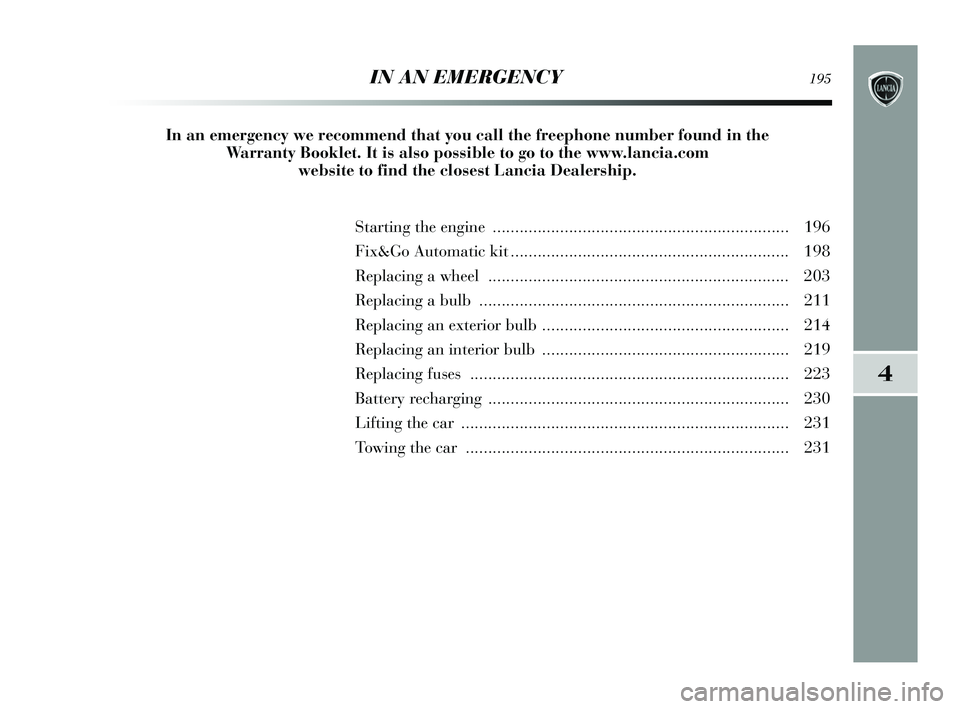
4
IN AN EMERGENCY195
Starting the engine .................................................................. 196
Fix&Go Automatic kit.............................................................. 198
Replacing a wheel ................................................................... 203
Replacing a bulb ..................................................................... 211
Replacing an exterior bulb ....................................................... 214
Replacing an interior bulb ....................................................... 219
Replacing fuses ....................................................................... 223
Battery recharging ................................................................... 230
Lifting the car ........................................................................\
. 231
Towing the car ........................................................................\
231
In an emergency we recommend that you call the freephone number found in\
the
Warranty Booklet. It is also possible to go to the www.lancia.com website to find the closest Lancia Dealership.
195-232 Delta GB 1ed 03/03/14 09.14 Pagina 195
Page 198 of 291

196IN AN EMERGENCY
STARTING THE ENGINE
Go to a Lancia Dealership immediately if instrument pan-
el
Ywarning light remains on constantly.
JUMP STARTING fig. 1
If the battery is flat, the engine may be started using an
auxiliary battery with the same capacity or a little high-
er than the flat one.
fig. 1L0E0074m
Strictly avoid using a rapid battery charger
for jump starting: this could damage the elec-
tronic systems and the engine fuel supply and
ignition control units.
This starting procedure must be carried out
by expert personnel as incorrect manoeuvres
can cause electrical discharges of consider-
able intensity. Furthermore, battery fluid is poiso-
nous and corrosive: avoid contact with skin and
eyes. Keep naked flames away from the battery. No
smoking. Do not cause sparks.
195-232 Delta GB 1ed 03/03/14 09.14 Pagina 196
Page 199 of 291

IN AN EMERGENCY197
4
Proceed as follows to start the car:
❍connect the positive terminals (+ sign close to the ter-
minal) of both batteries using a lead;
❍ with a second lead, connect the negative terminal –
of the auxiliary battery to an earthing point E
on the
engine or the gearbox of the car to be started;
❍ start the engine;
❍ when the engine has been started, follow the sequence
above in reverse order to remove the leads.
If after a few attempts the engine does not start, do not
persist but contact a Lancia Dealership.
IMPORTANT Do not directly connect the negative ter-
minals of the two batteries: any sparks may ignite the ex-
plosive gas which could come out of the battery. If the aux-
iliary battery is installed on another car, prevent any con-
tact between metal parts of the two cars. BUMP STARTING
Never bump start the engine by pushing, towing or coast-
ing downhill.
This could cause fuel to flow into the catalytic converter
and damage it beyond repair.
IMPORTANT Remember that the brake servo and elec-
trical power steering system (where provided) are not op-
erational until the engine is started, a greater effort will
therefore be required to press the brake pedal or turn the
steering wheel.
195-232 Delta GB 1ed 03/03/14 09.14 Pagina 197
Page 227 of 291

IN AN EMERGENCY225
4
Engine compartment fuse box fig. 40 and 41
A second fuse box is located on the right side of the en-
gine compartment, next to the battery. To access this fuse
box release the side tabs and remove cover L. The ID num-
ber of the electrical component corresponding to each fuse
can be found on the back of the cover.
fig. 40L0E0088m
If you need to wash the engine compartment,
take care not to directly aim for the engine
compartment fuse box with the jet of water.
fig. 41L0E0210m
195-232 Delta GB 1ed 03/03/14 09.15 Pagina 225
Page 232 of 291
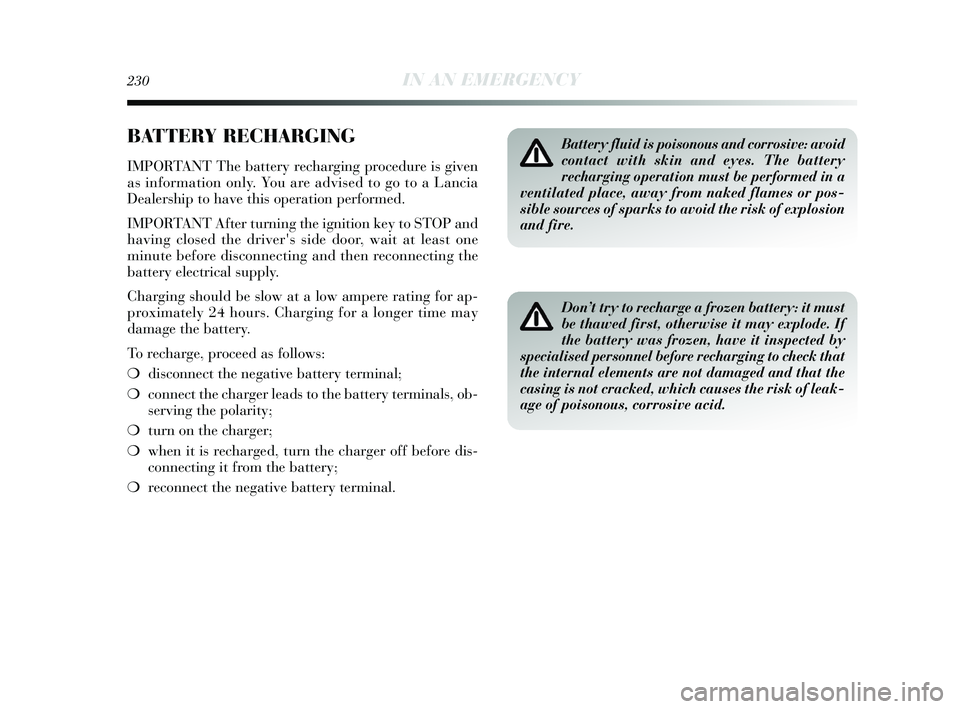
230IN AN EMERGENCY
BATTERY RECHARGING
IMPORTANT The battery recharging procedure is given
as information only. You are advised to go to a Lancia
Dealership to have this operation performed.
IMPORTANT After turning the ignition key to STOP and
having closed the driver's side door, wait at least one
minute before disconnecting and then reconnecting the
battery electrical supply.
Charging should be slow at a low ampere rating for ap-
proximately 24 hours. Charging for a longer time may
damage the battery.
To recharge, proceed as follows:
❍disconnect the negative battery terminal;
❍ connect the charger leads to the battery terminals, ob-
serving the polarity;
❍ turn on the charger;
❍ when it is recharged, turn the charger off before dis-
connecting it from the battery;
❍ reconnect the negative battery terminal.
Battery fluid is poisonous and corrosive: avoid
contact with skin and eyes. The battery
recharging operation must be performed in a
ventilated place, away from naked flames or pos-
sible sources of sparks to avoid the risk of explosion
and fire.
Don’t try to recharge a frozen battery: it must
be thawed first, otherwise it may explode. If
the battery was frozen, have it inspected by
specialised personnel before recharging to check that
the internal elements are not damaged and that the
casing is not cracked, which causes the risk of leak-
age of poisonous, corrosive acid.
195-232 Delta GB 1ed 03/03/14 09.15 Pagina 230
Page 235 of 291
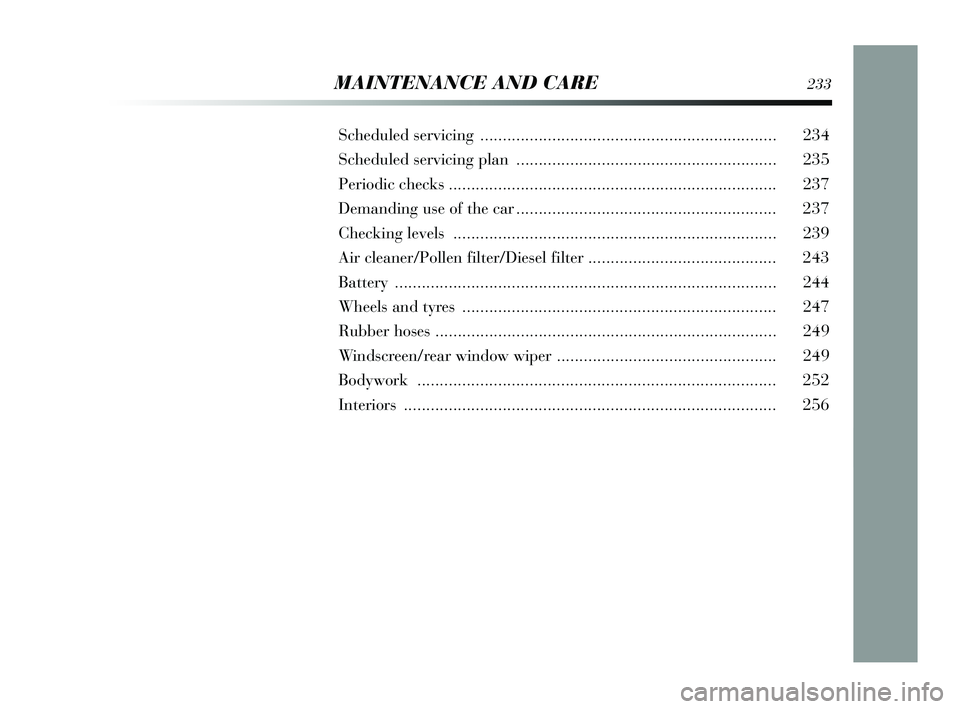
MAINTENANCE AND CARE233
Scheduled servicing .................................................................. 234
Scheduled servicing plan .......................................................... 235
Periodic checks ........................................................................\
. 237
Demanding use of the car .......................................................... 237
Checking levels ........................................................................\
239
Air cleaner/Pollen filt er/Diesel filter.......................................... 243
Battery .......................................................................\
.............. 244
Wheels and ty res ...................................................................... 247
Rubber hoses ......................................................................\
...... 249
Windscreen/rear window wiper ................................................. 249
Bodywork ........................................................................\
........ 252
Interiors ........................................................................\
........... 256
233-256 Delta GB 1ed 03/04/14 13:27 Pagina 233
Page 237 of 291
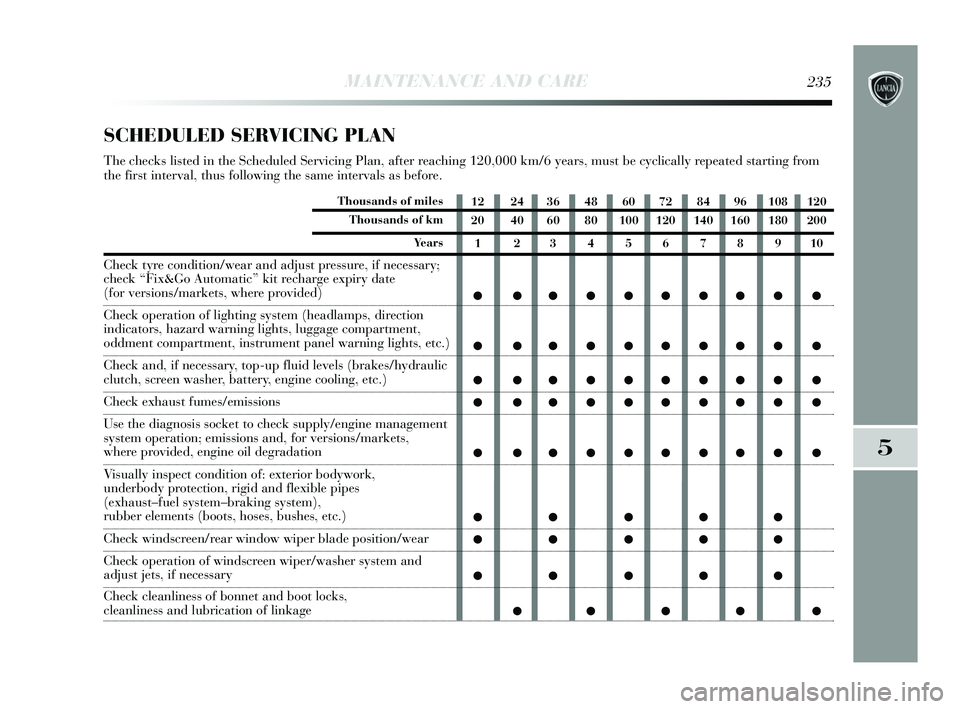
MAINTENANCE AND CARE235
5
12 24 36 48 60 72 84 96 108 120
20 40 60 80 100 120 140 160 180 2001 2345678910
● ●●●●●●●● ●
● ●●●●●●●● ●
● ●●●●●●●● ●
● ●●●●●●●● ●
● ●●●●●●●● ●
● ● ●●●
● ● ●●●
● ● ●●● ●●●● ●
SCHEDULED SERVICING PLAN
The checks listed in the Scheduled Servicing Plan, after reaching 120,000 km/6 years, must be cyclically repeated starting from
the first interval, thus following the same intervals as before.
Thousands of miles
Thousands of km
Years
Check tyre condition/wear and adjust pressure, if necessary;
check “Fix&Go Automatic” kit recharge expiry date
(for versions/markets, where provided)
Check operation of lighting system (headlamps, direction
indicators, hazard warning lights, luggage compartment,
oddment compartment, instrument panel warning lights, etc.)
Check and, if necessary, top-up fluid levels (brakes/hydraulic
clutch, screen washer, battery, engine cooling, etc.)
Check exhaust fumes/emissions
Use the diagnosis socket to check supply/engine management
system operation; emissions and, for versions/markets,
where provided, engine oil degradation
Visually inspect condition of: exterior bodywork,
underbody protection, rigid and flexible pipes
(exhaust–fuel system–braking system),
rubber elements (boots, hoses, bushes, etc.)
Check windscreen/rear window wiper blade position/wear
Check operation of windscreen wiper/washer system and
adjust jets, if necessary
Check cleanliness of bonnet and boot locks,
cleanliness and lubrication of linkage
233-256 Delta GB 1ed 03/04/14 13:27 Pagina 235
Page 240 of 291
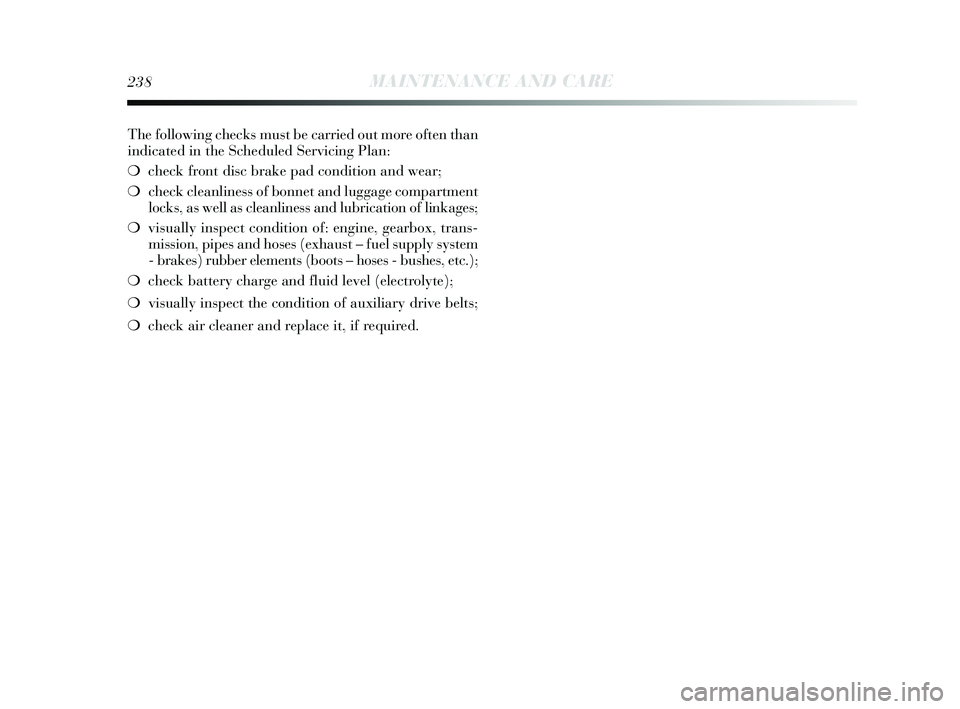
The following checks must be carried out more often than
indicated in the Scheduled Servicing Plan:
❍check front disc brake pad condition and wear;
❍ check cleanliness of bonnet and luggage compartment
locks, as well as cleanliness and lubrication of linkages;
❍ visually inspect condition of: engine, gearbox, trans-
mission, pipes and hoses (exhaust – fuel supply system
- brakes) rubber elements (boots – hoses - bushes, etc.);
❍ check battery charge and fluid level (electrolyte);
❍ visually inspect the condition of auxiliary drive belts;
❍ check air cleaner and replace it, if required.
238MAINTENANCE AND CARE
233-256 Delta GB 1ed 03/04/14 13:27 Pagina 238